The Quantitative Impact of the Arable Land Protection Policy on the Landscape of Farmland Abandonment in Guangdong Province
Abstract
:1. Introduction
2. Materials and Methods
2.1. Description of the Study Area
2.2. Data Preprocessing
2.3. Land Use Transfer Matrix for Farmland Abandonment Calculation
2.4. Future Farmland Abandonment Simulation
2.5. Simulation Distribution Evaluation
2.6. Landscape Indices of Farmland Abandonment Calculation
2.7. Quantitative Analysis of the Impact of the Arable Land Protection Policy
3. Results
3.1. The Spatiotemporal Patterns of Farmland Abandonment in Guangdong Province
3.2. Changes in Different Farmland Abandonment Types
3.3. Validation Results
3.4. The Impact of Land Use Policies on Farmland Abandonment Management
3.5. The Impact of Arable Land Policies on Prefectures with Different Urbanization Levels
4. Discussion
4.1. The Contributions and Limitations
4.2. The Effectiveness of Arable Land Policy under Rapid Urbanization
4.3. The Influence of Agricultural Labour Forces on Farmland Abandonment
5. Conclusions
Author Contributions
Funding
Data Availability Statement
Conflicts of Interest
References
- Gellrich, M.; Zimmermann, N.E. Investigating the regional-scale pattern of agricultural land abandonment in the Swiss mountains: A spatial statistical modelling approach. Landsc Urban Plan. 2007, 79, 65–76. [Google Scholar] [CrossRef]
- Li, S.; Li, X. Global understanding of farmland abandonment: A review and prospects. J. Geogr. Sci. 2017, 27, 1123–1150. [Google Scholar] [CrossRef]
- Terres, J.-M.; Scacchiafichi, L.N.; Wania, A.; Ambar, M.; Anguiano, E.; Buckwell, A.; Coppola, A.; Gocht, A.; Källström, H.N.; Pointereau, P.; et al. Farmland abandonment in Europe: Identification of drivers and indicators, and development of a composite indicator of risk. Land Use Policy 2015, 49, 20–34. [Google Scholar] [CrossRef]
- Wu, Y.; Shan, L.; Guo, Z.; Peng, Y. Cultivated land protection policies in China facing 2030: Dynamic balance system versus basic farmland zoning. Habitat Int. 2017, 69, 126–138. [Google Scholar] [CrossRef]
- Chen, W.; Cheshmehzangi, A.; Mangi, E.; Heath, T. Implementations of China’s New-Type Urbanisation: A Comparative Analysis between Targets and Practices of Key Elements’ Policies. Sustainability 2022, 14, 6341. [Google Scholar] [CrossRef]
- Levers, C.; Schneider, M.; Prishchepov, A.V.; Estel, S.; Kuemmerle, T. Spatial variation in determinants of agricultural land abandonment in Europe. Sci Total Environ 2018, 644, 95–111. [Google Scholar] [CrossRef] [PubMed]
- Estel, S.; Kuemmerle, T.; Alcántara, C.; Levers, C.; Prishchepov, A.; Hostert, P. Mapping farmland abandonment and recultivation across Europe using MODIS NDVI time series. Remote Sens. Environ. 2015, 163, 312–325. [Google Scholar] [CrossRef]
- Deng, X.; Huang, J.; Rozelle, S.; Zhang, J.; Li, Z. Impact of urbanization on cultivated land changes in China. Land Use Policy 2015, 45, 1–7. [Google Scholar] [CrossRef]
- Jiang, L.; Deng, X.; Seto, K.C. The impact of urban expansion on agricultural land use intensity in China. Land Use Policy 2013, 35, 33–39. [Google Scholar] [CrossRef]
- Xu, D.; Deng, X.; Guo, S.; Liu, S. Labor migration and farmland abandonment in rural China: Empirical results and policy implications. J. Environ. Manage. 2019, 232, 738–750. [Google Scholar] [CrossRef]
- Chen, L.; Meadows, M.E.; Liu, Y.; Lin, Y. Examining pathways linking rural labour outflows to the abandonment of arable land in China. Popul. Space Place 2022, 28, e2591. [Google Scholar] [CrossRef]
- Deng, X.; Xu, D.; Qi, Y.; Zeng, M. Labor Off-Farm Employment and Cropland Abandonment in Rural China: Spatial Distribution and Empirical Analysis. Int. J. Environ. Res. Public Health 2018, 15, 1808. [Google Scholar] [CrossRef] [PubMed] [Green Version]
- Wei, Z.; Gu, X.; Sun, Q.; Hu, X.; Gao, Y. Analysis of the spatial and temporal pattern of changes in abandoned farmland based on long time series of remote sensing data. Remote Sens. 2021, 13, 2549. [Google Scholar] [CrossRef]
- Zhang, X.; Liu, K.; Wang, S.; Long, X.; Li, X. A Rapid Model (COV_PSDI) for Winter Wheat Mapping in Fallow Rotation Area Using MODIS NDVI Time-Series Satellite Observations: The Case of the Heilonggang Region. Remote Sens. 2021, 13, 4870. [Google Scholar] [CrossRef]
- Liu, Y.; Wang, J. Revealing Annual Crop Type Distribution and Spatiotemporal Changes in Northeast China Based on Google Earth Engine. Remote Sens. 2022, 14, 4056. [Google Scholar] [CrossRef]
- Li, G.; Cao, Y.; He, Z.; He, J.; Cao, Y.; Wang, J.; Fang, X. Understanding the Diversity of Urban–Rural Fringe Development in a Fast Urbanizing Region of China. Remote Sens. 2021, 13, 2373. [Google Scholar] [CrossRef]
- Eggen, M.; Ozdogan, M.; Zaitchik, B.F.; Simane, B. Land cover classification in complex and fragmented agricultural landscapes of the Ethiopian highlands. Remote Sens. 2016, 8, 1020. [Google Scholar] [CrossRef] [Green Version]
- Knauer, K.; Gessner, U.; Fensholt, R.; Forkuor, G.; Kuenzer, C. Monitoring agricultural expansion in Burkina Faso over 14 years with 30 m resolution time series: The role of population growth and implications for the environment. Remote Sens. 2017, 9, 132. [Google Scholar] [CrossRef] [Green Version]
- Mottet, A.; Ladet, S.; Coqué, N.; Gibon, A. Agricultural land-use change and its drivers in mountain landscapes: A case study in the Pyrenees. Agric. Ecosyst. Environ. 2006, 114, 296–310. [Google Scholar] [CrossRef]
- Atalová, B.; Pulerová, J.; Tefunková, D.; Dobrovodská, M.; Vlachoviová, M.; Kozelová, I. Monitoring and evaluating the contribution of the rural development program to high nature value farmland dominated by traditional mosaic landscape in Slovakia. Ecol. Indic. 2021, 126, 107661. [Google Scholar] [CrossRef]
- Li, M.; Xie, Y.; Li, Y. Transition of rural landscape patterns in Southwest China’s mountainous area: A case study based on the Three Gorges Reservoir Area. Environ. Earth Sci. 2021, 80, 742. [Google Scholar] [CrossRef]
- Liu, X.; Zhao, C.; Wei, S. Review of the evolution of cultivated land protection policies in the period following China’s reform and liberalization. Land Use Policy 2017, 67, 660–669. [Google Scholar] [CrossRef]
- Zhou, X.X.; Zhu, Z.H.; Feng, C. The evolution of land policies in China from 1980 to 2019: A policy-text based analysis. Environ. Sci. Pollut. Res. 2022, 29, 54902–54915. [Google Scholar] [CrossRef]
- Cheng, Q.; Jiang, P.; Cai, L.; Shan, J.; Zhang, Y.; Wang, L.; Li, M.; Li, F.; Zhu, A.; Chen, D. Delineation of a permanent basic farmland protection area around a city centre: Case study of Changzhou city, China. Land Use Policy 2017, 60, 73–89. [Google Scholar]
- Kuang, B.; Han, J.; Lu, X.; Zhang, X.; Fan, X. Quantitative evaluation of China’s cultivated land protection policies based on the PMC-Index model. Land Use Policy 2020, 99, 105062. [Google Scholar] [CrossRef]
- Shi, K.; Yang, Q.; Li, Y.; Sun, X. Mapping and evaluating cultivated land fallow in Southwest China using multisource data. Sci. Total Environ. 2019, 654, 987–999. [Google Scholar] [CrossRef]
- Wang, C.; Siriwardana, M.; Meng, S. Effects of the Chinese arable land fallow system and land-use change on agricultural production and on the economy. Econ. Model. 2019, 79, 186–197. [Google Scholar] [CrossRef]
- Yin, R.; Liu, C.; Zhao, M.; Yao, S.; Liu, H. The implementation and impacts of China’s largest payment for ecosystem services program as revealed by longitudinal household data. Land Use Policy 2014, 40, 45–55. [Google Scholar] [CrossRef]
- Zhu, Z.; Liu, L.; Chen, Z.; Zhang, J.; Verburg, P.H. Land-use change simulation and assessment of driving factors in the loess hilly region—A case study as Pengyang County. Environ. Monit. Assess. 2010, 164, 133–142. [Google Scholar] [CrossRef]
- Hussain, S.; Mubeen, M.; Ahmad, A.; Majeed, H.; Qaisrani, S.A.; Hammad, H.M.; Amjad, M.; Ahmad, I.; Fahad, S.; Ahmad, N. Assessment of land use/land cover changes and its effect on land surface temperature using remote sensing techniques in Southern Punjab, Pakistan. Environ. Sci. Pollut. Res. 2022. [Google Scholar] [CrossRef]
- Gong, J.; Chen, W.; Liu, Y.; Wang, J. The intensity change of urban development land: Implications for the city master plan of Guangzhou, China. Land Use Policy 2014, 40, 91–100. [Google Scholar] [CrossRef]
- Tan, S.; Zhang, L.; Qi, R. Research on regional pressure index of cultivated land based on system dynamics—A case study of Hubei province. J. Nat. Resour. 2012, 5, 757–764. [Google Scholar]
- Zhao, J.; Yuan, L.; Zhang, M. A study of the system dynamics coupling model of the driving factors for multi-scale land use change. Environ. Earth Sci. 2016, 75, 1–13. [Google Scholar] [CrossRef]
- Du, X.; Zhao, X.; Liang, S.; Zhao, J.; Wu, D. Quantitatively Assessing and Attributing Land Use and Land Cover Changes on China’s Loess Plateau. Remote Sens. 2020, 12, 353. [Google Scholar] [CrossRef] [Green Version]
- Hengsdijk, H.; Ittersum, M.K.v.; Rossing, W.A.H. Quantitative analysis of farming systems for policy formulation: Development of new tools. Agric. Syst. 1998, 58, 381–394. [Google Scholar] [CrossRef]
- Liang, X.; Li, Y.; Zhou, Y. Study on the abandonment of sloping farmland in Fengjie County, Three Gorges Reservoir Area, a mountainous area in China. Land Use Policy 2020, 97, 104760. [Google Scholar] [CrossRef]
- He, Y.; Xie, H.; Peng, C. Analyzing the behavioural mechanism of farmland abandonment in the hilly mountainous areas in China from the perspective of farming household diversity. Land Use Policy 2020, 99, 104826. [Google Scholar] [CrossRef]
- Benenson, I.; Torrens, P.M. Modeling Urban Land-Use with Cellular Automata; Geosimulation: Brooklyn, NY, USA, 2006. [Google Scholar]
- He, C.; Okada, N.; Zhang, Q.; Shi, P.; Zhang, J. Modeling urban expansion scenarios by coupling cellular automata model and system dynamic model in Beijing, China. Appl. Geogr. 2006, 26, 323–345. [Google Scholar] [CrossRef]
- Jiao, J. Simulation of Dynamic Urban Expansion under Ecological Constraints Using a Long Short Term Memory Network Model and Cellular Automata. Remote Sens. 2021, 13, 1499. [Google Scholar]
- Gidey, E.; Dikinya, O.; Sebego, R.; Segosebe, E.; Zenebe, A. Cellular automata and Markov Chain (CA_Markov) model-based predictions of future land use and land cover scenarios (2015–2033) in Raya, northern Ethiopia. Model. Earth Syst. Environ. 2017, 3, 1245–1262. [Google Scholar] [CrossRef]
- Gounaridis, D.; Chorianopoulos, I.; Symeonakis, E.; Koukoulas, S. A Random Forest-Cellular Automata modelling approach to explore future land use/cover change in Attica (Greece), under different socio-economic realities and scales. Sci. Total Environ. 2019, 646, 320–335. [Google Scholar] [CrossRef] [PubMed]
- Liu, X.; Liang, X.; Li, X.; Xu, X.; Ou, J.; Chen, Y.; Li, S.; Wang, S.; Pei, F. A future land use simulation model (FLUS) for simulating multiple land use scenarios by coupling human and natural effects. Landsc. Urban Plan. 2017, 168, 94–116. [Google Scholar] [CrossRef]
- Verburg, P.H.; Overmars, K.P. Combining top-down and bottom-up dynamics in land use modeling: Exploring the future of abandoned farmlands in Europe with the Dyna-CLUE model. Landsc. Ecol. 2009, 24, 1167. [Google Scholar] [CrossRef]
- Zhu, X.; Xiao, G.; Zhang, D.; Guo, L. Mapping abandoned farmland in China using time series MODIS NDVI. Sci. Total Environ. 2021, 755, 142651. [Google Scholar] [CrossRef]
- Li, L.; Pan, Y.; Zheng, R.; Liu, X. Understanding the spatiotemporal patterns of seasonal, annual, and consecutive farmland abandonment in China with time-series MODIS images during the period 2005–2019. Land Degrad. Dev. 2022, 33, 1608–1625. [Google Scholar] [CrossRef]
- Ustaoglu, E.; Collier, M.J. Farmland abandonment in europe: An overview of drivers, consequences and assessment of the sustainability implications. Environ. Rev. 2018, 26, 396–416. [Google Scholar] [CrossRef]
- Zhou, Y. System Driven Analysis of National Economic Growth: Guangdong as an Example. Am. J. Ind. Bus. Manag. 2017, 07, 27–30. [Google Scholar] [CrossRef] [Green Version]
- Asselen, S.V.; Verburg, P.H. Land cover change or land-use intensification: Simulating land system change with a global-scale land change model. Glob. Change Biol. 2014, 19, 3648–3667. [Google Scholar] [CrossRef]
- Ornetsmüller, C.; Verburg, P.H.; Heinimann, A. Scenarios of land system change in the Lao PDR: Transitions in response to alternative demands on goods and services provided by the land. Appl. Geogr. 2016, 75, 1–11. [Google Scholar] [CrossRef] [Green Version]
- Sarah, W.; Schrammeijer, E.A.; Schulp, C.; Verburg, P.H. Meeting global land restoration and protection targets: What would the world look like in 2050? Glob. Environ. Change 2018, 52, 259–272. [Google Scholar]
- Pontius Jr, R.G.; Schneider, L.C. Land-cover change model validation by an ROC method for the Ipswich watershed, Massachusetts, USA. Agric. Ecosyst. Environ. 2001, 85, 239–248. [Google Scholar] [CrossRef]
- McHugh, M.L. Interrater reliability: The kappa statistic. Biochem. Med. 2012, 22, 276–282. [Google Scholar] [CrossRef]
- Fu, B.; Liang, D.; Lu, N. Landscape ecology: Coupling of pattern, process, and scale. Chin. Geogr. Sci. 2011, 21, 385–391. [Google Scholar] [CrossRef]
- Šímová, P.; Gdulová, K. Landscape indices behavior: A review of scale effects. Appl. Geogr. 2012, 34, 385–394. [Google Scholar] [CrossRef]
- Kuchma, T.; Tarariko, O.; Syrotenko, O. Landscape Diversity Indexes Application for Agricultural Land Use Optimization. Procedia Technol. 2013, 8, 566–569. [Google Scholar] [CrossRef] [Green Version]
- Jiang, P.; Li, M.; Lv, J. The causes of farmland landscape structural changes in different geographical environments. Sci. Total Environ. 2019, 685, 667–680. [Google Scholar] [CrossRef]
- Liang, X.; Li, Y.; Ran, C.; Li, M.; Zhang, H. Study on the transformed farmland landscape in rural areas of southwest China: A case study of Chongqing. J. Rural. Stud. 2020, 76, 272–285. [Google Scholar] [CrossRef]
- Fu, B.-J.; Hu, C.-X.; Chen, L.-D.; Honnay, O.; Gulinck, H. Evaluating change in agricultural landscape pattern between 1980 and 2000 in the Loess hilly region of Ansai County, China. Agric. Eco. Environ. 2006, 114, 387–396. [Google Scholar] [CrossRef]
- Mann, H.B. Non-parametric tests against trend. Econometrica 1945, 13, 245–259. [Google Scholar] [CrossRef]
- Litchfield Jr, J.T.; Wilcoxon, F. Rank correlation method. Anal. Chem. 1955, 27, 299–300. [Google Scholar] [CrossRef]
- Hamed, K.H. Trend detection in hydrologic data: The Mann–Kendall trend test under the scaling hypothesis. J. Hydrol. 2008, 349, 350–363. [Google Scholar] [CrossRef]
- Baumann, M.; Kuemmerle, T.; Elbakidze, M.; Ozdogan, M.; Radeloff, V.C.; Keuler, N.S.; Prishchepov, A.V.; Kruhlov, I.; Hostert, P. Patterns and drivers of post-socialist farmland abandonment in Western Ukraine. Land Use Policy 2011, 28, 552–562. [Google Scholar] [CrossRef]
- Shi, T.; Li, X.; Xin, L.; Xu, X. The spatial distribution of farmland abandonment and its influential factors at the township level: A case study in the mountainous area of China. Land Use Policy 2018, 70, 510–520. [Google Scholar] [CrossRef]
- Yin, H.; Prishchepov, A.V.; Kuemmerle, T.; Bleyhl, B.; Buchner, J.; Radeloff, V.C. Mapping agricultural land abandonment from spatial and temporal segmentation of Landsat time series. Remote Sens. Environ. 2018, 210, 12–24. [Google Scholar] [CrossRef]
- lei, Y.Z.; Lei, L.; Hua, Z.; Jinshe, L. Exploring the Factors Driving Seasonal Farmland Abandonment: A Case Study at the Regional Level in Hunan Province, Central China. Sustainability 2017, 9, 187. [Google Scholar]
- Keenleyside, C.; Tucker, G. Farmland Abandonment in the EU: An Assessment of Trends and Prospects; Institute for European Environmental Policy: London, UK, 2010. [Google Scholar]
- Colin, C. The Conditions of Economic Progress, 2nd ed.; Macmillan: London, UK, 1951. [Google Scholar]
- Yang, L. An Empirical Study of Farmers’ Perception and Behavior on Farmland Abandonment in Yunnan Province. Asian Agric. Res. 2017, 3, 63–65. [Google Scholar]
- Ruskule, A.; Nikodemus, O.; Kasparinskis, R.; Bell, S.; Urtane, I. The perception of abandoned farmland by local people and experts: Landscape value and perspectives on future land use. Landsc Urban Plan 2013, 115, 49–61. [Google Scholar] [CrossRef]
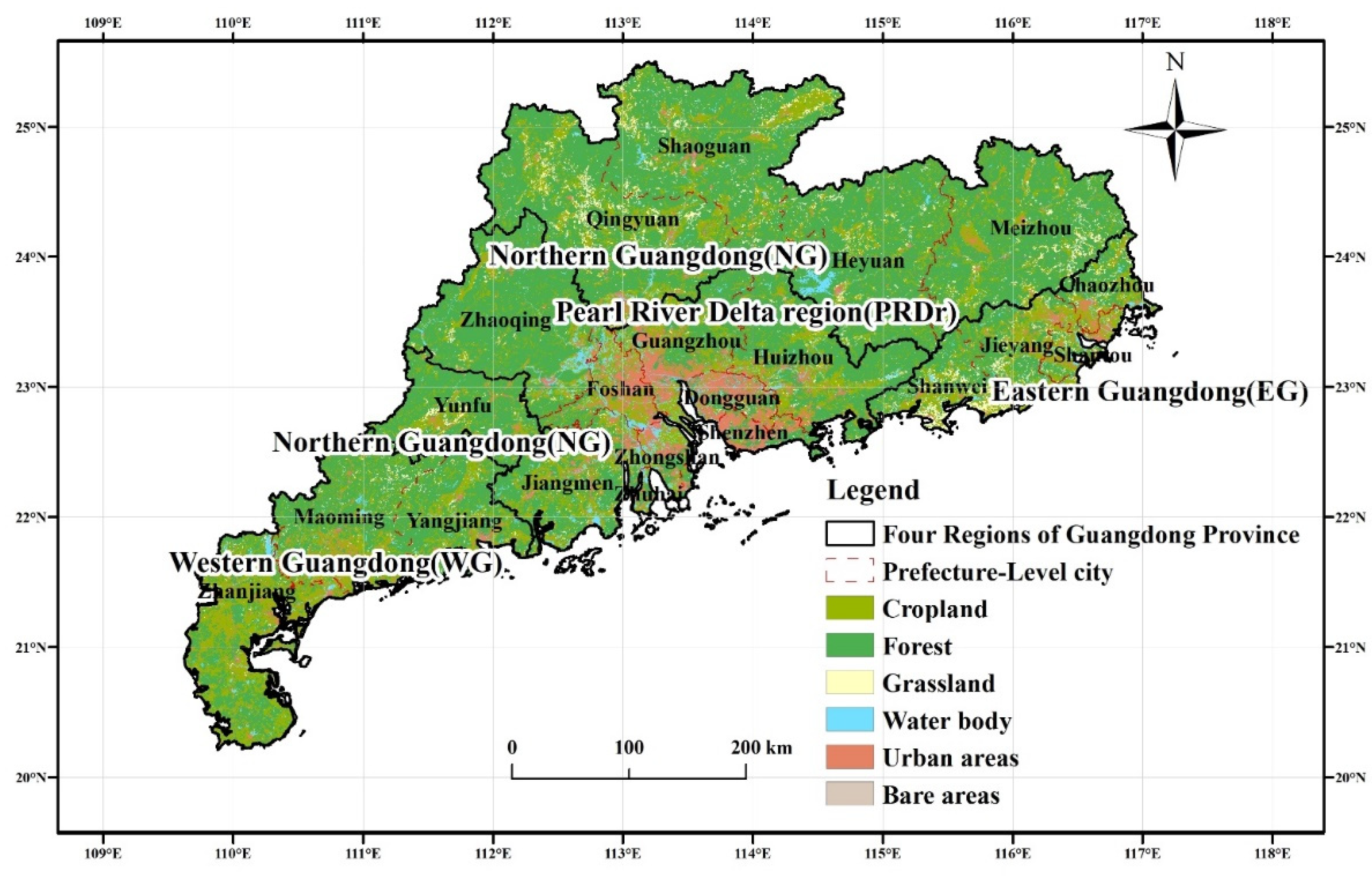

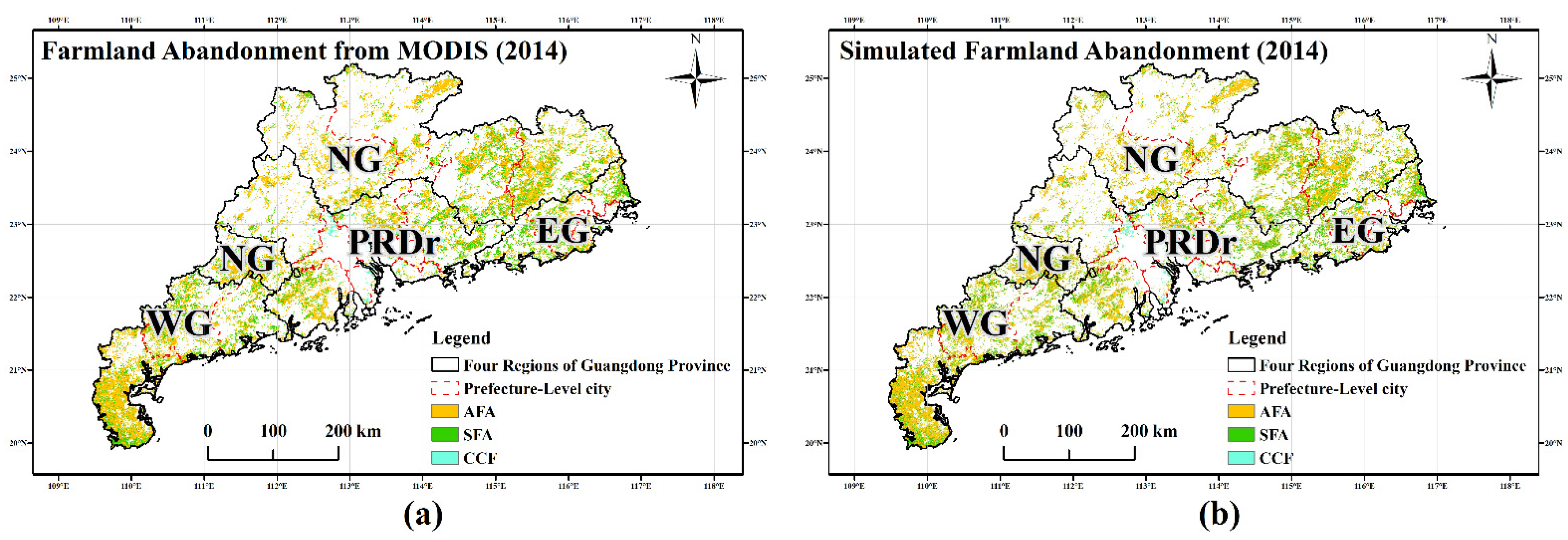
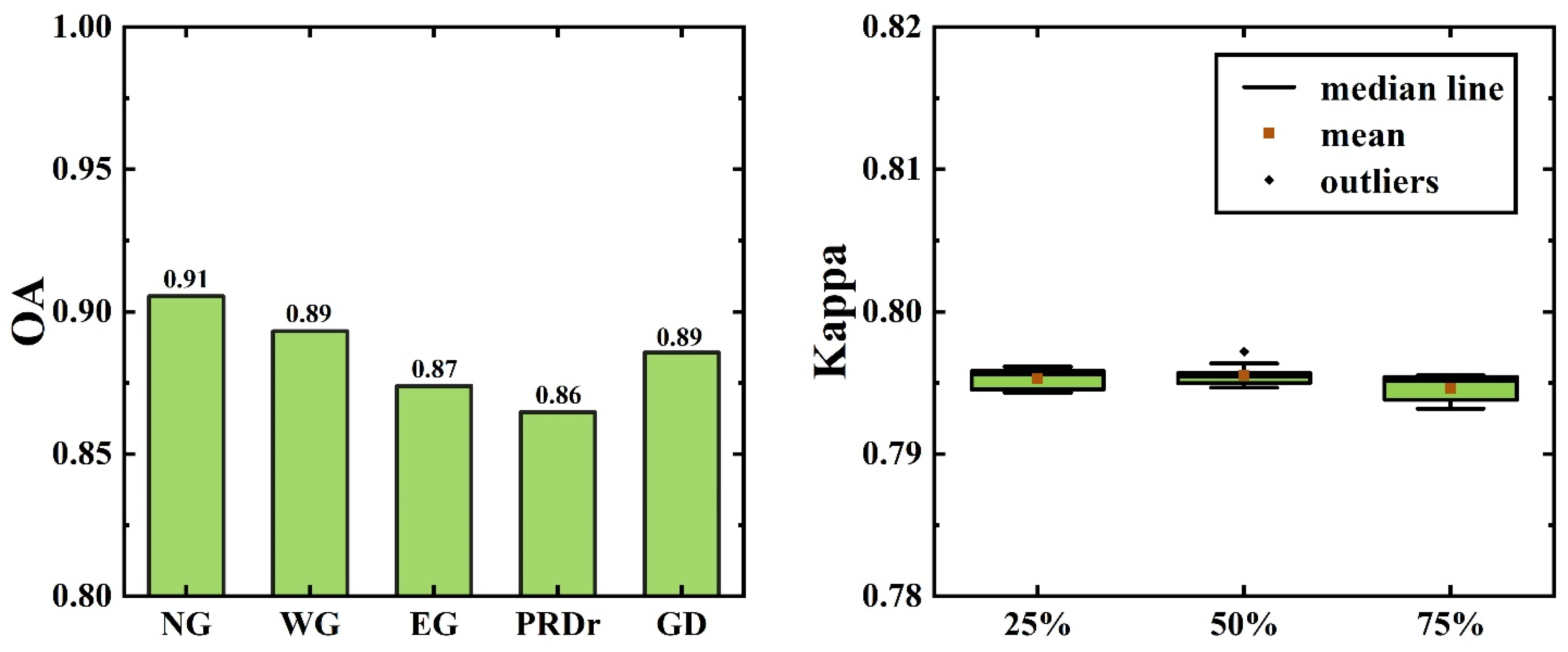
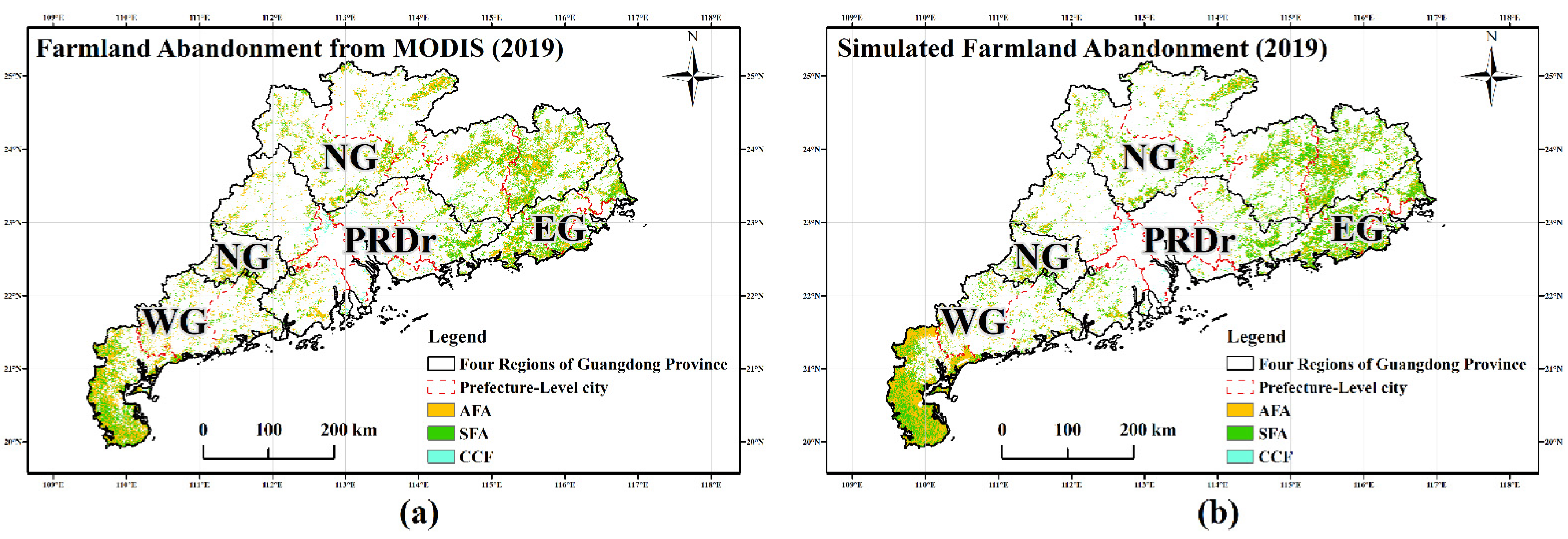

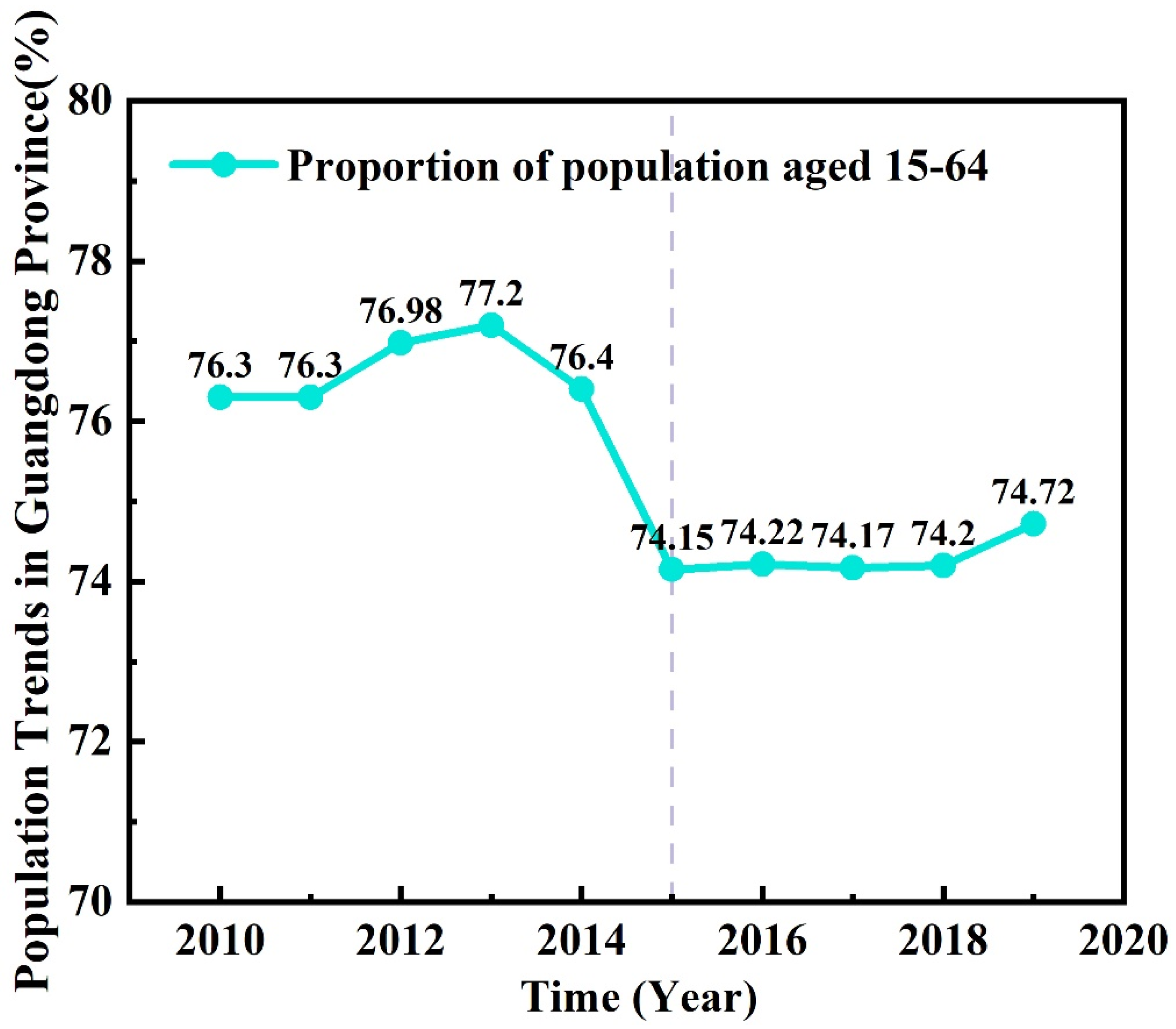
| Land Use Types | AFA | SFA | CCF | Other Land |
|---|---|---|---|---|
| AFA | 1 | 1 | 1 | 1 |
| SFA | 1 | 1 | 1 | 1 |
| CCF | 1 | 1 | 1 | 1 |
| Other land | 1 | 1 | 1 | 1 |
| Indicators | Formulas | Definition of Variables |
|---|---|---|
| Number of patches (NP) | refers to the number of abandoned farmland patches. | |
| Mean patch size (MPS) | refers to the area of abandoned farmland patches; refers to the number of abandoned farmland patches. | |
| Aggregation index (AI) | refers to the number of like adjacencies between pixels of farmland abandonment patch type i based on single-count method; refers to the maximum number of like adjacencies between pixels of farmland abandonment patch type I based on the single-count method; refers to the proportion of landscape comprised of farmland abandonment of patch type i. |
| Landscape Indicator | Region | 2010–2014 | 2015–2019 | ||||
|---|---|---|---|---|---|---|---|
| Regression Function * | R2 | Significance T/F | Regression Function * | R2 | Significance T/F | ||
| NP | NG | y = 27.90x − 53,565.80 | 0.01 | F | y = 55.10x + 113,291.20 | 0.18 | F |
| EG | y = 91.00x − 182,664.40 | 0.87 | T | y = −16.20x + 32,963.00 | 0.35 | F | |
| WG | y = 11.30x − 21,655.00 | 0.01 | F | y = −12.40x + 26,169.00 | 0.01 | F | |
| PRDr | y = 34.80x − 67,884.40 | 0.07 | F | y = 126.90x − 253,179.80 | 0.77 | F | |
| GD | y = 376.60x − 751,679.00 | 0.92 | T | y = 138.40x − 272,707.80 | 0.52 | F | |
| MPS | NG | y = −2.92x + 5944.30 | 0.09 | F | y = 5.68x − 11,346.45 | 0.81 | F |
| EG | y = −51.50x + 103,786.17 | 0.93 | F | y = 0.27x − 364.55 | 0.03 | F | |
| WG | y = −2.57x + 5286.60 | 0.02 | F | y = −5.74x + 11,666.06 | 0.23 | F | |
| PRDr | y = −0.62x + 1287.89 | 0.01 | F | y = −1.191x + 2468.78 | 0.16 | F | |
| GD | y = −5.67x + 11,488.11 | 0.77 | F | y = −1.23x + 2562.52 | 0.19 | F | |
| AI | NG | y = −1.05x + 2185.10 | 0.31 | F | y = 0.97x − 1866.86 | 0.81 | F |
| EG | y = −1.90x + 3895.57 | 0.69 | F | y = 0.14x − 194.02 | 0.03 | F | |
| WG | y = −0.26x + 602.98 | 0.01 | F | y = −1.52x + 3144.95 | 0.23 | F | |
| PRDr | y = −4.03x + 8167.79 | 0.95 | T | y = −1.21x + 2468.68 | 0.16 | F | |
| GD | y = −0.84x + 1766.73 | 0.90 | F | y = 3.17x − 6285.89 | 0.19 | F | |
| Type | AFA (kha) | SFA (kha) | CCF (kha) | Other Land (kha) | Total (kha) | |
|---|---|---|---|---|---|---|
| 2010–2014 | AFA | 1394.17 | 796.03 | 6.61 | 1227.75 | 3424.57 |
| SFA | 496.58 | 245.08 | 2.60 | 390.56 | 1134.82 | |
| CCF | 12.66 | 2.53 | 63.41 | 53.23 | 131.84 | |
| Other land | 1128.84 | 384.44 | 37.19 | 10,078.20 | 11,628.67 | |
| Total | 3032.25 | 1428.08 | 109.82 | 11,749.74 | 16,319.89 | |
| 2015–2019 | AFA | 712.25 | 740.08 | 4.24 | 947.50 | 2404.07 |
| SFA | 400.03 | 375.20 | 1.92 | 438.37 | 1215.53 | |
| CCF | 12.99 | 5.35 | 42.00 | 44.95 | 105.29 | |
| Other land | 703.59 | 491.98 | 32.67 | 11,366.75 | 12,595.00 | |
| Total | 1828.87 | 1612.61 | 80.83 | 12,797.58 | 16,319.89 |
Publisher’s Note: MDPI stays neutral with regard to jurisdictional claims in published maps and institutional affiliations. |
© 2022 by the authors. Licensee MDPI, Basel, Switzerland. This article is an open access article distributed under the terms and conditions of the Creative Commons Attribution (CC BY) license (https://creativecommons.org/licenses/by/4.0/).
Share and Cite
Li, L.; Zheng, S.; Zhao, K.; Shen, K.; Yan, X.; Zhao, Y. The Quantitative Impact of the Arable Land Protection Policy on the Landscape of Farmland Abandonment in Guangdong Province. Remote Sens. 2022, 14, 4991. https://doi.org/10.3390/rs14194991
Li L, Zheng S, Zhao K, Shen K, Yan X, Zhao Y. The Quantitative Impact of the Arable Land Protection Policy on the Landscape of Farmland Abandonment in Guangdong Province. Remote Sensing. 2022; 14(19):4991. https://doi.org/10.3390/rs14194991
Chicago/Turabian StyleLi, Le, Siyan Zheng, Kefei Zhao, Kejian Shen, Xiaolu Yan, and Yaolong Zhao. 2022. "The Quantitative Impact of the Arable Land Protection Policy on the Landscape of Farmland Abandonment in Guangdong Province" Remote Sensing 14, no. 19: 4991. https://doi.org/10.3390/rs14194991
APA StyleLi, L., Zheng, S., Zhao, K., Shen, K., Yan, X., & Zhao, Y. (2022). The Quantitative Impact of the Arable Land Protection Policy on the Landscape of Farmland Abandonment in Guangdong Province. Remote Sensing, 14(19), 4991. https://doi.org/10.3390/rs14194991







